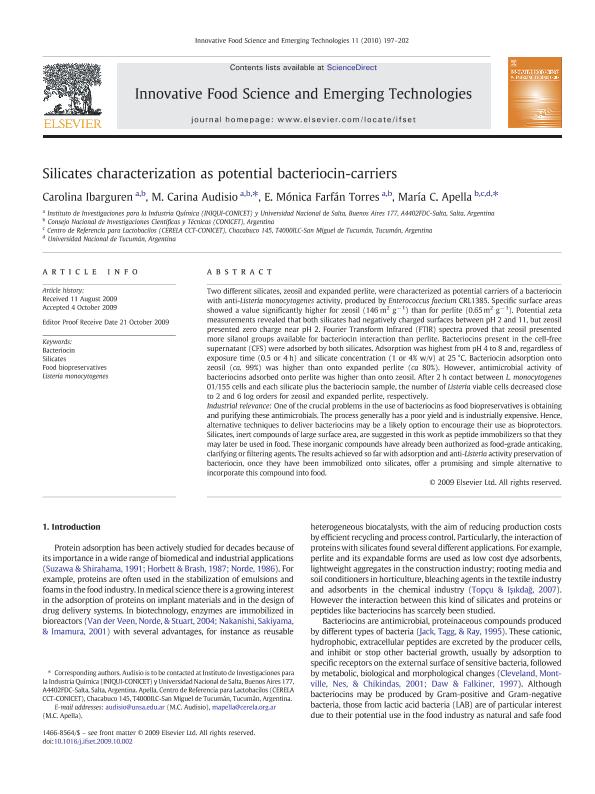Artículo
Silicates characterization as potential bacteriocin-carriers
Fecha de publicación:
01/2010
Editorial:
Elsevier
Revista:
Innovative Food Science & Emerging Technologies
ISSN:
1466-8564
e-ISSN:
1878-5522
Idioma:
Inglés
Tipo de recurso:
Artículo publicado
Clasificación temática:
Resumen
Two different silicates, zeosil and expanded perlite, were characterized as potential carriers of a bacteriocin with anti-Listeria monocytogenes activity, produced by Enterococcus faecium CRL1385. Specific surface areas showed a value significantly higher for zeosil (146 m2 g- 1) than for perlite (0.65 m2 g- 1). Potential zeta measurements revealed that both silicates had negatively charged surfaces between pH 2 and 11, but zeosil presented zero charge near pH 2. Fourier Transform Infrared (FTIR) spectra proved that zeosil presented more silanol groups available for bacteriocin interaction than perlite. Bacteriocins present in the cell-free supernatant (CFS) were adsorbed by both silicates. Adsorption was highest from pH 4 to 8 and, regardless of exposure time (0.5 or 4 h) and silicate concentration (1 or 4% w/v) at 25 °C. Bacteriocin adsorption onto zeosil (ca. 99%) was higher than onto expanded perlite (ca 80%). However, antimicrobial activity of bacteriocins adsorbed onto perlite was higher than onto zeosil. After 2 h contact between L. monocytogenes 01/155 cells and each silicate plus the bacteriocin sample, the number of Listeria viable cells decreased close to 2 and 6 log orders for zeosil and expanded perlite, respectively. Industrial relevance: One of the crucial problems in the use of bacteriocins as food biopreservatives is obtaining and purifying these antimicrobials. The process generally has a poor yield and is industrially expensive. Hence, alternative techniques to deliver bacteriocins may be a likely option to encourage their use as bioprotectors. Silicates, inert compounds of large surface area, are suggested in this work as peptide immobilizers so that they may later be used in food. These inorganic compounds have already been authorized as food-grade anticaking, clarifying or filtering agents. The results achieved so far with adsorption and anti-Listeria activity preservation of bacteriocin, once they have been immobilized onto silicates, offer a promising and simple alternative to incorporate this compound into food.
Palabras clave:
Bacteriocin
,
Food Biopreservatives
,
Listeria Monocytogenes
,
Silicates
Archivos asociados
Licencia
Identificadores
Colecciones
Articulos(CERELA)
Articulos de CENTRO DE REFERENCIA PARA LACTOBACILOS (I)
Articulos de CENTRO DE REFERENCIA PARA LACTOBACILOS (I)
Articulos(INIQUI)
Articulos de INST.DE INVEST.PARA LA INDUSTRIA QUIMICA (I)
Articulos de INST.DE INVEST.PARA LA INDUSTRIA QUIMICA (I)
Citación
Ibarguren, Carolina; Audisio, Marcela Carina; Farfan Torres, Elsa Monica; Apella, Maria Cristina; Silicates characterization as potential bacteriocin-carriers; Elsevier; Innovative Food Science & Emerging Technologies; 11; 1; 1-2010; 197-202
Compartir
Altmétricas




